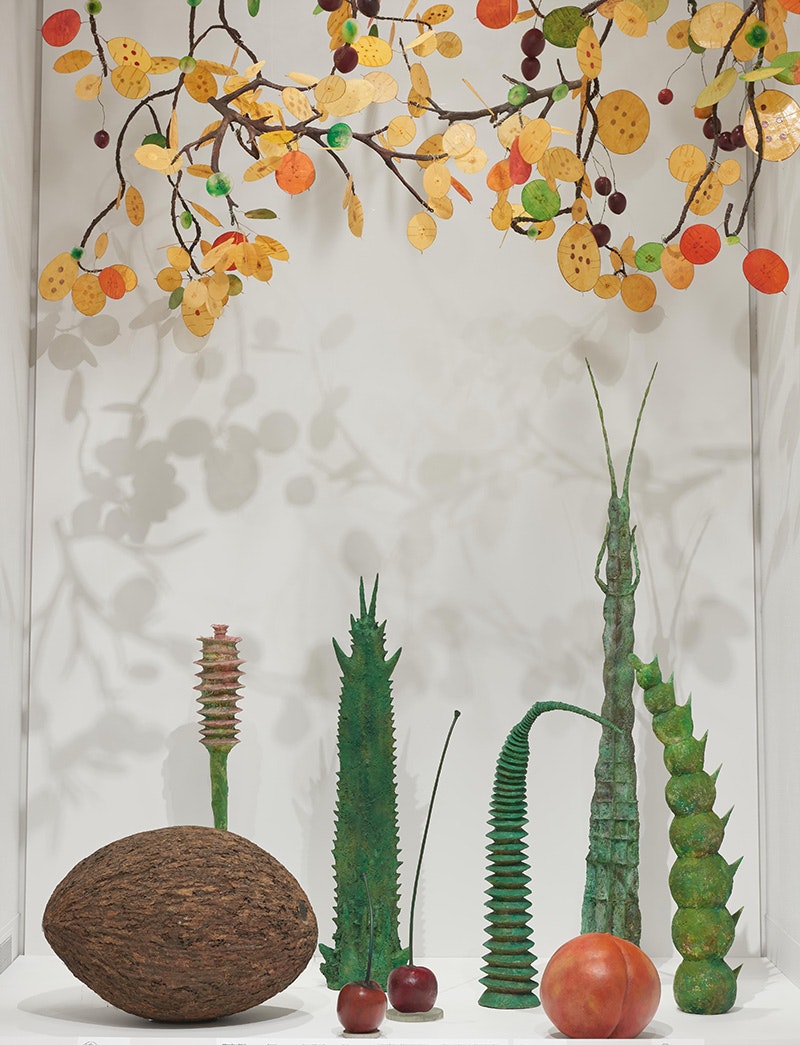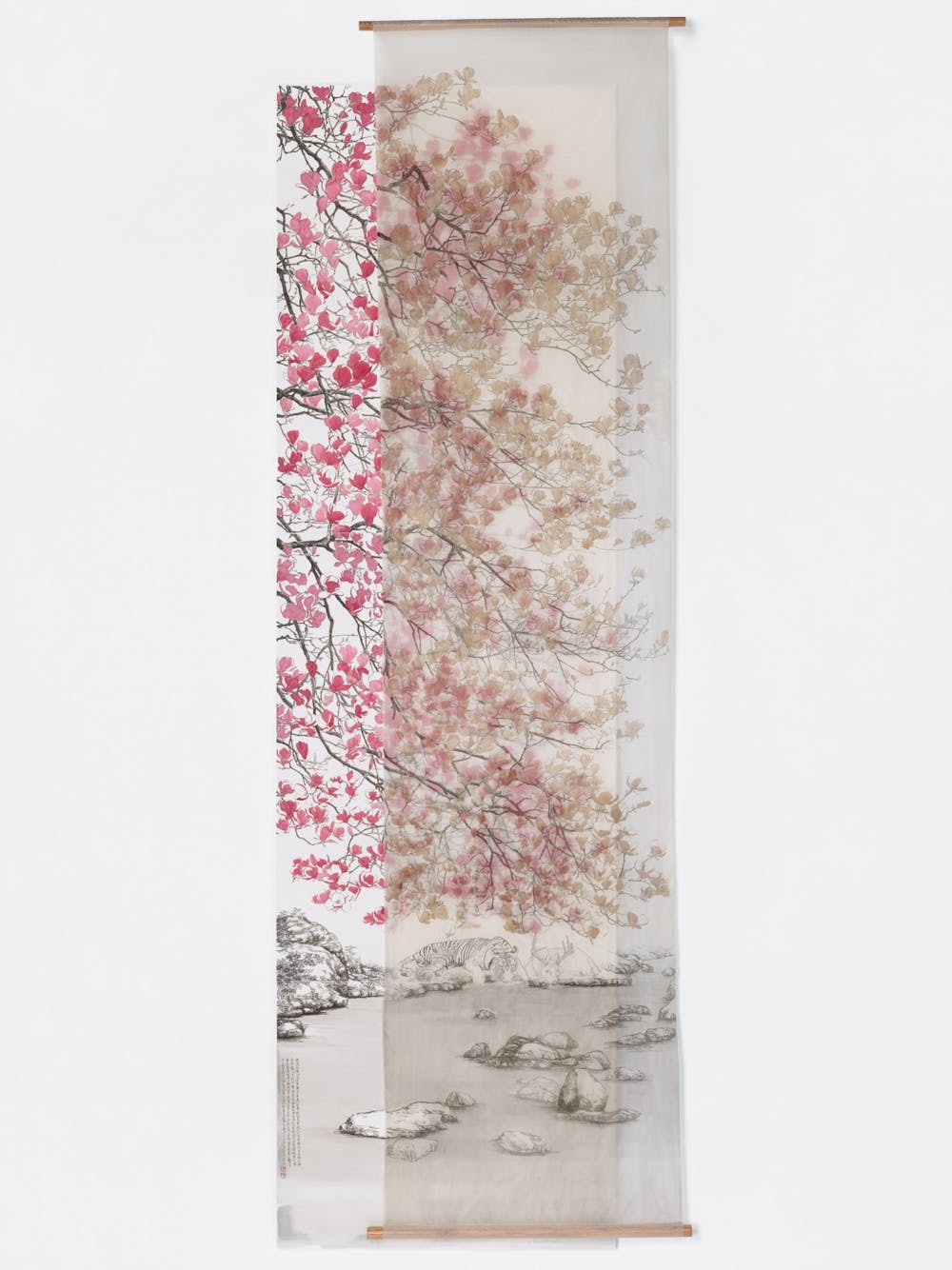Oneness:
Nature & Connectivity in Chinese Art
The Brooklyn Rail Sept Print
By Hindley Wang
Philadelphia Museum Of Art
Oneness: Nature & Connectivity in Chinese Art
November 30, 2022–October 29, 2023

“The greatest shanshui tradition is our god, the greatest nature is our shanshui, the greatest shanshui is my own body,” narrates the artist Bingyi in a video that accompanies her installation, The Eye of Chaos: Remaking the Song Palace (2021–2022.) In this multi-scroll piece, organic abstractions create eerie juxtapositions. The video documents the artist’s body moving on and with her painting. This surrender and embrace punctures the veil of representation that sustains the tradition of shanshui, and exposes the surface of rendering to the whims of weather. Pictorial likeness becomes a false proposition when the ink is swapped, strokes stained, and paper strayed with the direct bent of the mountain, the rain, the wind, and time. The immediate bleeds into the meditated—a precarious intimacy that soils the purified order of aesthetics.
The rest of the featured work is placed adjacent to select pieces from the museum’s permanent collection of Chinese art: notably the sixteenth century monument—Sixteen Flowers. This Ming Dynasty masterpiece by Xu Wei (1521–1593) depicts the unlikely event of a simultaneous bloom: symbolic floras of the four seasons are arranged to occupy the same continuum. Soft, succulent plantain leaves (summer) lurk behind the sharp, decisive extend of the bamboo, like contemplative puddles, or nebulous shadows adorning the tips of the bamboo leaves. Tracing down the spine of the long stems, you find the elegant composure of plum blossom (winter) sticking out the bush, with brushstrokes that denote a resilient unfurl. Quick dabs like pebbles, the camellia leaves hover above hydrangea blossoms. Sprawling out the cavernous rock are an assemblage of chrysanthemums.


This captivating aporia is echoed in Ming Fay’s sculptures. Staging a whimsical anthropomorphic response to the Daoist association of good virtues with the expression of flora and plant life, Ming Fay imagines the connectivity between humanity and nature otherwise. Money Tree Garden, Hybrid plants and Fruit (1984–2022), transforms horticultural bodies into free-standing individuals. An oversized coconut stands next to two cherries with long stems and a glossy peach. Behind the recognizable stand an array of five life-like herbs and hybrid beings. Cordyceps Cousin (2000), takes its form after the medicinal cult of cordyceps—a fungus growing on the body of caterpillars in the high mountains in China. This mutated cousin bears an exterior with the texture and spikes like a stink bug and the color of a soccer turf. Above, drapes the long hanging fruit from the Money Tree Garden suspended in the air. The mundane lounges in the shade of the spectacular.
The mimetic tension between the contemporary and the ancient contributes to an eloquent curation in the limited space. A Qing Dynasty Emperor’s Robe (Long Pao) hangs near Tai Xiangzhou’s celestial drama of heaven and earth in Fanghu Isle of the Immortals (2021). Mansheng Wang’s Tiger and Deer Drinking Together (2022) renders an unexpected hesitation. Next to the Sixteen Flowers, this unconventional double-painting seems to be a note on copying—a traditional aesthetic apparatus of imitation and reinvention In fact it presents an impossibility: the predator drinking from the river beside its prey. Defying natural order and the construct of a homogenous pictorial plane, this coexistence is sustained in a material interface, a proximity in an overlap. Wang paints the deer on the silk scroll and the tiger on the rice paper. The transparency of the silk holds the ink like a suggestion, construing a phantasmic tracing over the opaque like an outline of an action misaligned with intent. Between the predator and prey, the positive is tucked behind the negative, the latter traces the former, the hunt is called off.